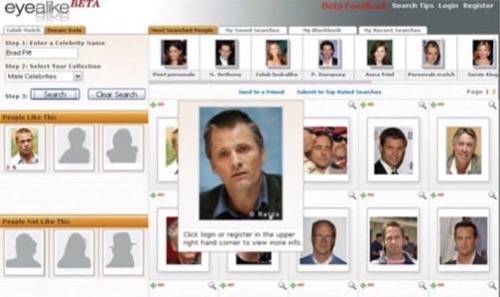Angel-funded ActiveSymbols is a privately held company that was founded in 2003 to develop a visual search platform. Four years and six key patent filings later, the company is ready to release phase one of that platform, focusing on facial recognition.

The Bellevue, Washington-based company, which enjoys a healthy research partnership with the University of Washington, is not aiming to create a destination site. Instead, ActiveSymbols aims to provide the technology for integrating facial recognition and image detection into image intensive web sites, or in the enterprise (for example, searching a large news photo database).
The company has released a tech demo, however, called Eyealike to show off their facial recognition platform. The site features two rather whimsical applications designed to put ActiveSymbols’ technology to the test, Celeb Match and Dream Date.
Both applications step actually on the other’s toes — they each do celebrity and personals search. In one, users can upload a photo of themselves and find celebrities who look like them according to the facial recognition and matching software. Or, they can upload a picture of someone they find attractive and search personals for people who look similar — for that demo, ActiveSymbols has 250k-300k images from Match.com and American Singles. The other application lets users do more or less the same two things, but starting with celebrity photos.

While these applications may seem frivolous, they’re nonetheless a good technical demo of the facial recognition technology. Company President Greg Heuss told me that eventually, ActiveSymbols will expand the platform beyond the online dating and social networking verticals. The company is hard at work converting their image recognition algorithms to video, which will hopefully result in more accurate automatic copyright surveillance software. Security and military intelligence applications of their software are another route that the company is exploring.
The technology works by breaking faces down into elements, identifying common features like eyes, nose, and mouth. The platform then attempts to extract data on the orientation and shape of the face, the skin tone, and the color and texture of the hair. Heuss told me that skin tone has generally proved to be the most difficult part of the facial recognition to master, an observation that bore out in my own testing of the platform. Using the “Celeb Match” application, I was oddly matched with a number of people whose skin tone was several shades darker than mine, likely due to the dark beard that obscures most of my face.
Heuss said the company is constantly tweaking the algorithm, and with more data the matching will improve.
The Eyealike demos probably make a lot of sense as a feature on dating sites, but they aren’t very compelling. Of course, that doesn’t mean there aren’t any worthwhile uses for good facial recognition technology (and it’s probably important to note that ActiveSymbols isn’t actually showing off any perfect face matching, but rather showing the ability of the platform to compare similar faces).
Imagine, for example, if instead of having to individually tag the face of each person in every single photo you upload to Facebook, the site used facial recognition software to learn what you friends look like via the photos of them it has already seen and tagged your new photos automatically. That would be pretty compelling.

















